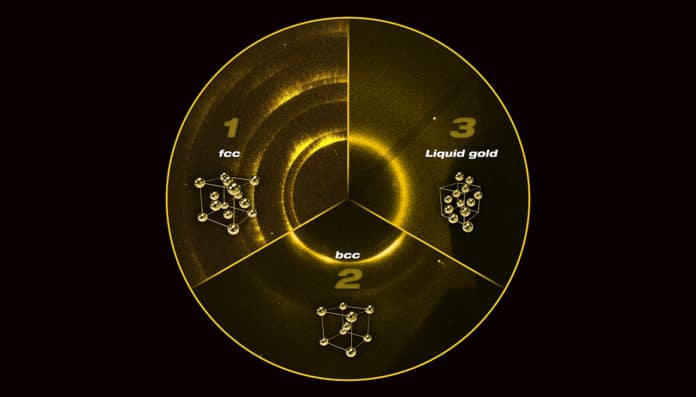Gold is a fascinating element. It’s among the least reactive, and its crystalline structure is predicted to be stable at incredibly high pressures. Despite this, the material is considered the “gold standard” for calculating the pressure in static diamond anvil cell experiments.
At the point when compressed gradually at room temperature (on the request for seconds to minutes), gold prefers to be the face-centered cubic (fcc) structure at weights up to three times the center of the Earth.
Recently, scientists at the Lawrence Livermore National Laboratory (LLNL) and the Carnegie Institution of Washington have discovered that at the point when gold is compressed quickly over nanoseconds (1 billionth of a second), the increase in pressure and temperature changes the crystalline structure to a new phase of gold. This outstanding body-centered cubic (bcc) structure transforms into a more open crystal structure than the fcc structure.
Lead author Richard Briggs, a postdoctoral researcher at LLNL said, “We discovered a new structure in gold that exists at extreme states—two-thirds of the pressure found at the center of Earth. The new structure actually has less efficient packing at higher pressures than the starting structure, which was surprising considering the vast amount of theoretical predictions that pointed to more tightly packed structures that should exist.”
Scientists conducted the experiments at the Dynamic Compression Sector (DCS) at the Advanced Photon Source, Argonne National Laboratory. DCS is the first synchrotron X-ray facility devoted to dynamic pressure science. These user experiments were some of the first conducted on hutch-C, the devoted high energy laser station of DCS. Gold was the perfect subject to think about because of its high-Z and generally unexplored phase diagram at high temperatures.
Scientists found that that the structure of gold began to change at a pressure of 220 GPa (2.2 million times Earth’s atmospheric pressure) and started to melt when compressed beyond 250 GPa.
Briggs said, “The observation of liquid gold at 330 GPa is astonishing. This is the pressure at the center of the Earth and is more than 300 GPa higher than previous measurements of liquid gold at high pressure.”
This conversion of fcc to bcc structure is maybe one of the most contemplated phase transitions because of its significance in the assembling of steel, where high temperatures or stress causes a change in structure between the two fcc/bcc structures.
Be that as it may, it isn’t realized what phase transition mechanism is responsible. The exploration group’s outcomes demonstrate that gold experienced a similar phase change before it melts, as a result of both pressure and temperature, and future tests concentrating on the instrument of the transition can help explain key details of this significant change for assembling strong steels.
Briggs said, “Many of the theoretical models of gold that are used to understand the high-pressure/high-temperature behavior did not predict the formation of a body-centered structure—only two out of more than 10 published works. Our results can help theorists improve their models of elements under extreme compression and look toward using those new models to examine the effects of chemical bonding to aid the development of new materials that can be formed at extreme states.”
The study is published in the journal Physical Review Letters.
